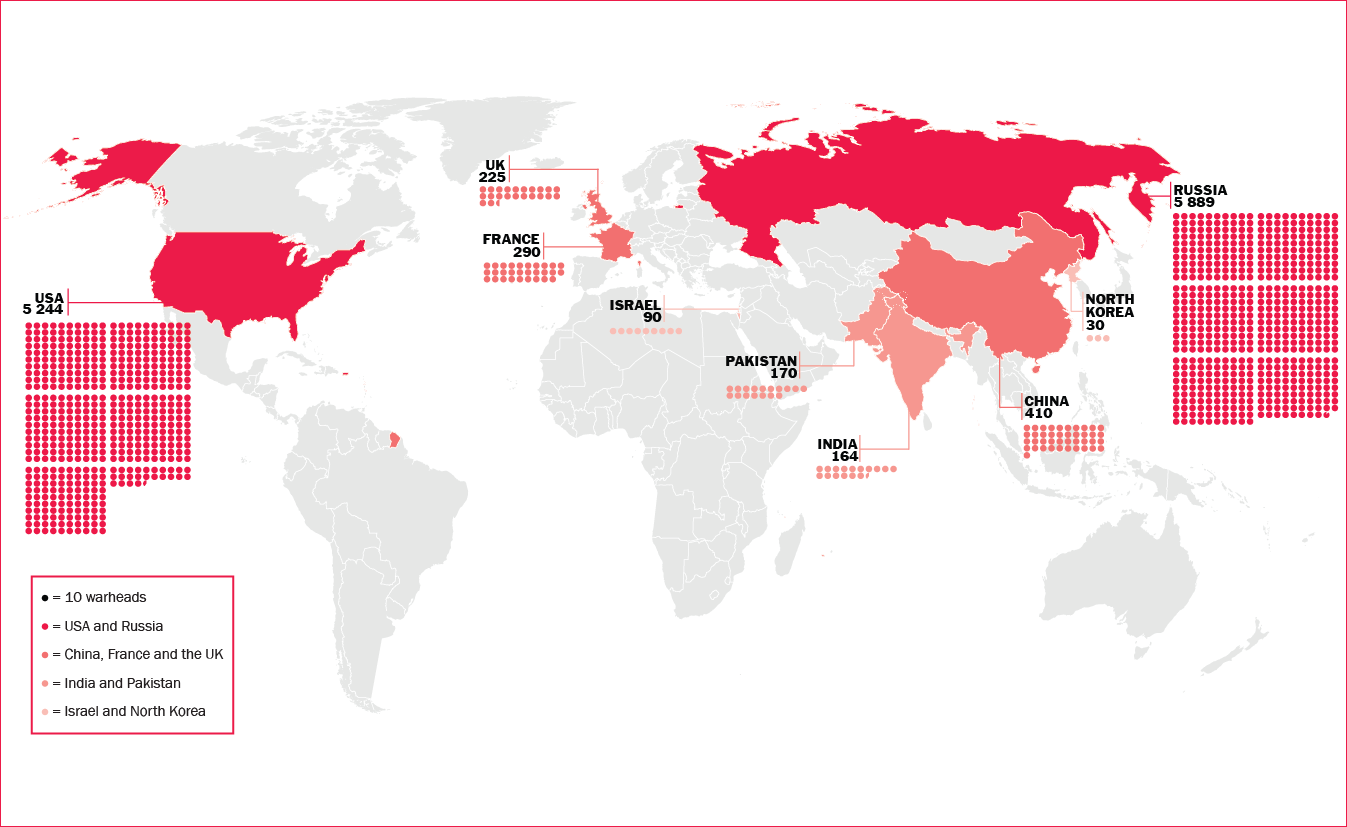7. World nuclear forces
Overview, Hans M. Kristensen and Matt Korda (PDF)
I. United States nuclear forces, Hans M. Kristensen and Matt Korda (PDF)
II. Russian nuclear forces, Hans M. Kristensen and Matt Korda (PDF)
III. British nuclear forces, Hans M. Kristensen and Matt Korda (PDF)
IV. French nuclear forces, Hans M. Kristensen and Matt Korda (PDF)
V. Chinese nuclear forces, Hans M. Kristensen and Matt Korda (PDF)
VI. Indian nuclear forces, Hans M. Kristensen and Matt Korda (PDF)
VII. Pakistani nuclear forces, Hans M. Kristensen and Matt Korda (PDF)
VIII. North Korean nuclear forces, Hans M. Kristensen and Matt Korda (PDF)
IX. Israeli nuclear forces, Hans M. Kristensen and Matt Korda (PDF)
X. Global stocks and production of fissile materials, 2022, Moritz Kütt, Zia Mian and Pavel Podvig, International Panel on Fissile Materials (PDF)
Click here to download the sample chapter on world nuclear forces (PDF).
At the start of 2023, nine states—the United States, Russia, the United Kingdom, France, China, India, Pakistan, the Democratic People’s Republic of Korea (DPRK, or North Korea) and Israel—together possessed approximately 12 512 nuclear weapons, of which 9576 were considered to be potentially operationally available. An estimated 3844 of these warheads were deployed with operational forces, including about 2000 that were kept in a state of high operational alert—the same number as the previous year.
Nuclear arsenals
Overall, the number of nuclear warheads in the world continues to decline. However, this is primarily due to the USA and Russia dismantling retired warheads. Global reductions of operational warheads appear to have stalled, and their numbers are rising again. At the same time, both the USA and Russia have extensive and expensive programmes under way to replace and modernize their nuclear warheads, their missile, aircraft and sub-marine delivery systems, and their nuclear weapon production facilities.
China is in the middle of a significant modernization and expansion of its nuclear arsenal. Its nuclear stockpile is expected to continue growing over the coming decade and some projections suggest that it will deploy at least as many intercontinental ballistic missiles (ICBMs) as either Russia or the USA in that period. However, China’s overall nuclear warhead stockpile is still expected to remain smaller than that of either of those states.
The nuclear arsenals of the other nuclear-armed states are even smaller, but all are either developing or deploying new weapon systems or have announced their intention to do so. India and Pakistan also appear to be increasing the size of their nuclear weapon inventories, and the UK has announced plans to increase its stockpile. North Korea’s military nuclear programme remains central to its national security strategy and it may have assembled up to 30 nuclear weapons and could produce more. North Korea conducted more than 90 ballistic missile tests during 2022—the highest number it has ever undertaken in a single year. Israel continues to maintain its long-standing policy of nuclear ambiguity, leaving significant uncertainty about the number and characteristics of its nuclear weapons.
Global nuclear weapon inventories, January 2023

Note: The boundaries used in this map do not imply any endorsement or acceptance by SIPRI.
Low levels of transparency
The availability of reliable information on the status of the nuclear arsenals and capabilities of the nuclear-armed states varies considerably. In some cases, estimates can be based on the amount of fissile material—plutonium and highly enriched uranium (HEU)—that a country is believed to have produced and on observations of missile forces.